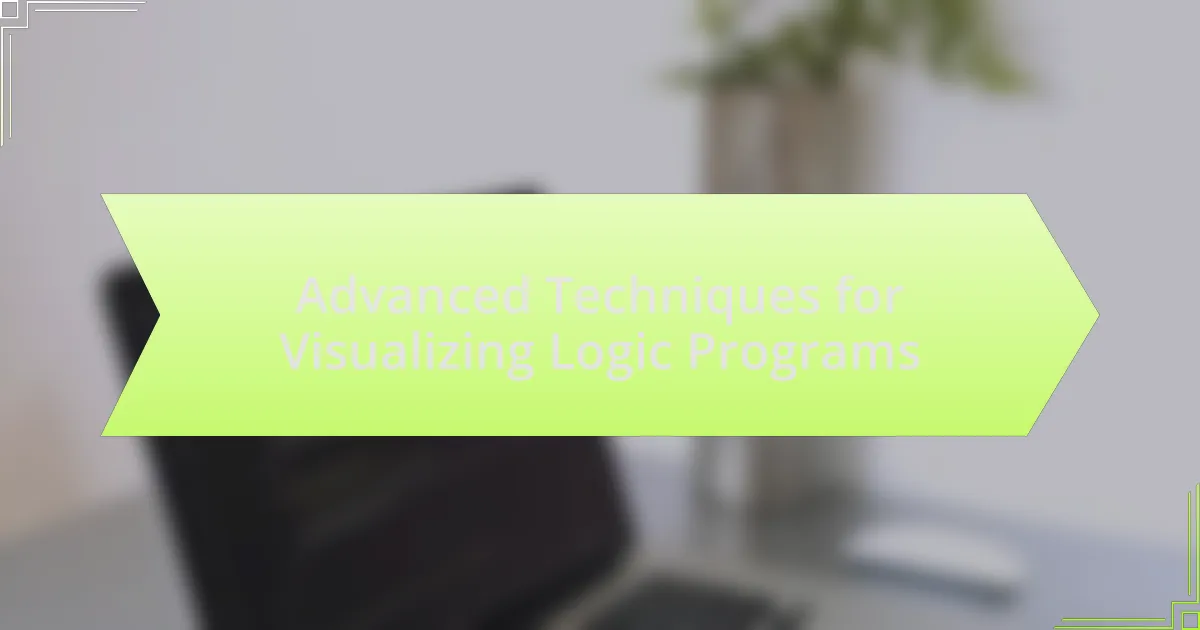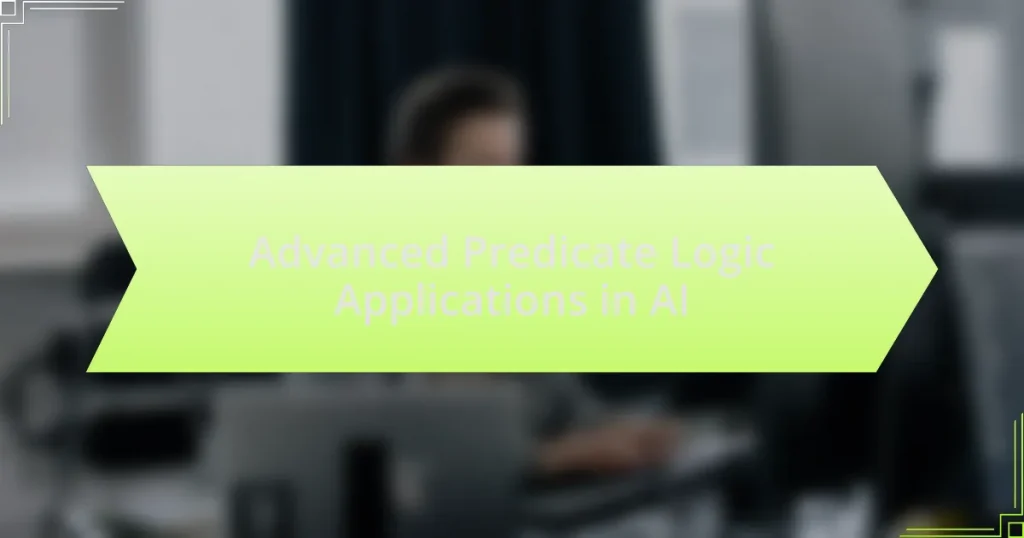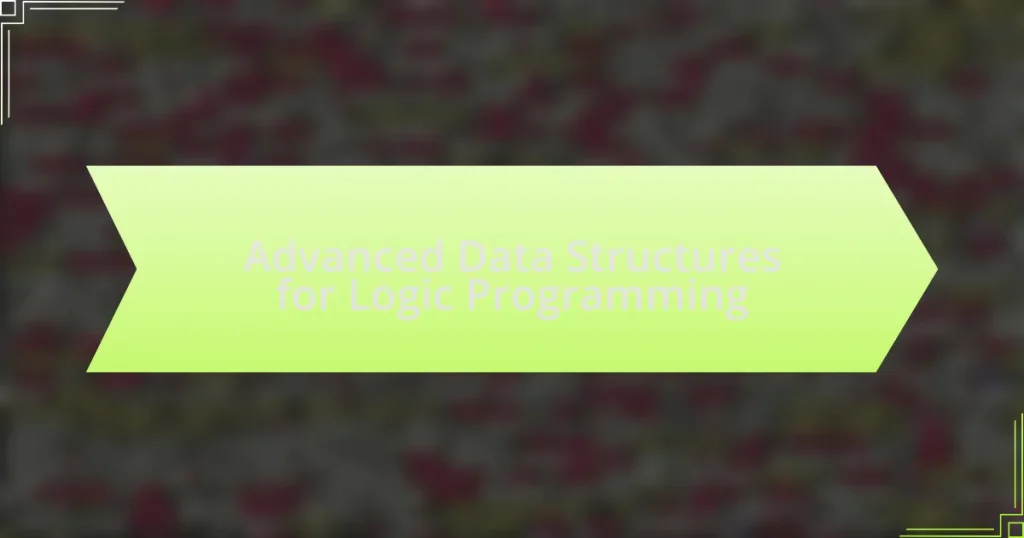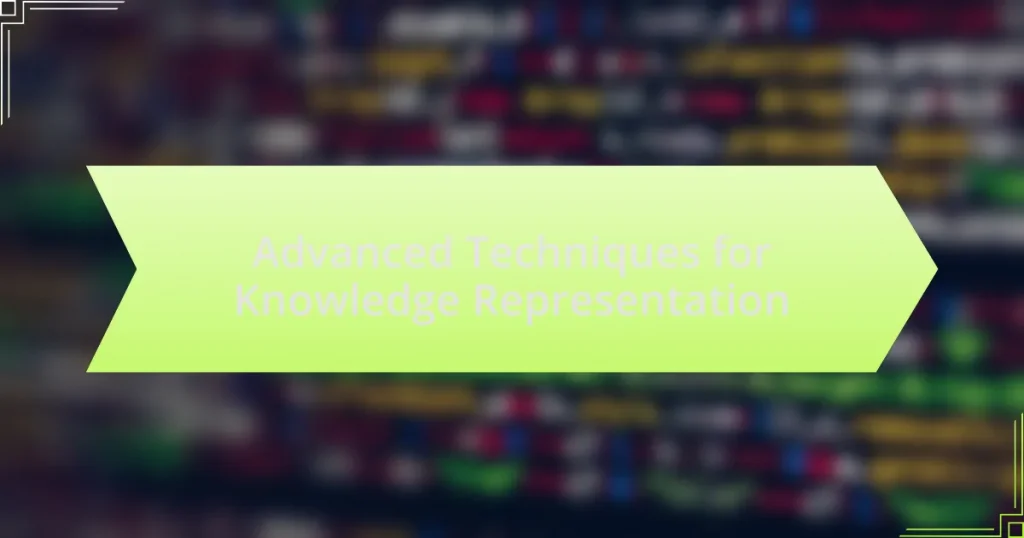Advanced techniques for visualizing logic programs encompass graph-based representations, model checking, and interactive visual environments, which enhance understanding and debugging of complex logic structures. These methods improve comprehension by providing clear visualizations of relationships and dependencies among predicates and rules, addressing challenges such as complexity management and dynamic data representation. Key components of effective visualization include clarity, interactivity, and representational accuracy, while commonly used tools like Prolog Visualizer and SWI-Prolog facilitate the exploration and analysis of logic programs. Emerging trends indicate a shift towards integrating artificial intelligence and machine learning to further enhance visualization processes, making logic programming more accessible and efficient for developers and educators alike.

What are Advanced Techniques for Visualizing Logic Programs?
Advanced techniques for visualizing logic programs include graph-based representations, model checking, and interactive visual environments. Graph-based representations, such as dependency graphs and argumentation frameworks, allow users to visualize relationships and dependencies among predicates and rules, enhancing understanding of program structure. Model checking techniques, like temporal logic visualization, enable the verification of properties in logic programs by providing visual feedback on state transitions and reachable states. Interactive visual environments, such as Prolog development tools with integrated visualization features, facilitate real-time exploration and debugging of logic programs, allowing users to manipulate and observe program behavior dynamically. These techniques improve comprehension and facilitate the debugging process, making logic programming more accessible and efficient.
How do these techniques enhance understanding of logic programs?
Advanced techniques for visualizing logic programs enhance understanding by providing clear, graphical representations of complex relationships and structures within the programs. These visualizations allow users to easily identify patterns, dependencies, and the flow of logic, which can be difficult to grasp through traditional textual representations alone. For instance, tools that utilize graph-based visualizations can illustrate how different predicates interact, making it easier to debug and optimize logic programs. Research has shown that visual aids significantly improve comprehension and retention of information, as they cater to diverse learning styles and facilitate quicker cognitive processing of abstract concepts.
What specific challenges do these techniques address in logic program visualization?
These techniques address challenges such as complexity management, which involves simplifying intricate logic structures for better understanding. They also tackle the issue of dynamic data representation, allowing for real-time updates and interactions with logic programs. Furthermore, these techniques improve accessibility by providing visual aids that cater to diverse learning styles, enhancing comprehension for users with varying backgrounds in logic programming. Lastly, they address the challenge of debugging by visually highlighting errors and inconsistencies, facilitating quicker identification and resolution of issues within logic programs.
How do advanced visualization techniques differ from traditional methods?
Advanced visualization techniques differ from traditional methods primarily in their ability to represent complex data in interactive and dynamic formats. Traditional methods often rely on static charts and graphs, which can limit the viewer’s understanding of intricate relationships within the data. In contrast, advanced techniques utilize interactive elements, such as 3D models, animations, and real-time data manipulation, allowing users to explore data from multiple perspectives and gain deeper insights. For example, tools like D3.js and Tableau enable users to create visualizations that respond to user input, enhancing engagement and comprehension. This shift towards interactivity and complexity in advanced visualization techniques significantly improves the ability to analyze and interpret large datasets compared to traditional static methods.
What are the key components of effective visualization in logic programming?
The key components of effective visualization in logic programming include clarity, interactivity, and representational accuracy. Clarity ensures that the visual representation is easily understandable, allowing users to grasp complex relationships and structures within the logic program. Interactivity enables users to manipulate the visualization, facilitating exploration and deeper insights into the program’s behavior. Representational accuracy guarantees that the visual elements accurately reflect the underlying logic, ensuring that the visualization is a true representation of the program’s semantics. These components collectively enhance the user’s ability to analyze and comprehend logic programs effectively.
Which visualization tools are most commonly used in logic programming?
The most commonly used visualization tools in logic programming include Prolog Visualizer, SWI-Prolog, and Visual Prolog. Prolog Visualizer allows users to visualize the execution of Prolog programs, providing a graphical representation of the program’s logic flow. SWI-Prolog offers built-in visualization features that help in debugging and understanding program behavior. Visual Prolog provides a comprehensive environment for developing and visualizing logic programs, enhancing user interaction with the logic structures. These tools are widely recognized in the field for their effectiveness in aiding the understanding and debugging of logic programming concepts.
How do different visualization methods impact the interpretation of logic programs?
Different visualization methods significantly impact the interpretation of logic programs by enhancing understanding and facilitating debugging. For instance, graphical representations such as dependency graphs allow users to visualize relationships between predicates, making it easier to identify logical connections and potential errors. Research by Shapiro and others in “Visualizing Logic Programs” demonstrates that visual tools can reduce cognitive load, enabling programmers to grasp complex structures more intuitively. Additionally, interactive visualizations can provide real-time feedback, allowing users to manipulate and explore logic programs dynamically, which further aids in comprehension and interpretation.

What are the benefits of using advanced visualization techniques in logic programming?
Advanced visualization techniques in logic programming enhance understanding, debugging, and communication of complex logical structures. These techniques allow programmers to visually represent relationships and dependencies within logic programs, making it easier to identify errors and optimize performance. For instance, visualizations can illustrate the flow of data and control, which aids in comprehending intricate logic and facilitates collaboration among team members. Studies have shown that visual aids improve cognitive processing, leading to more efficient problem-solving and reduced development time.
How do these techniques improve debugging and program analysis?
Advanced techniques for visualizing logic programs enhance debugging and program analysis by providing clearer insights into program behavior and structure. These techniques, such as graphical representations and interactive visualizations, allow developers to identify logical errors and inefficiencies more effectively. For instance, visualizing the flow of data and control can reveal hidden dependencies and interactions that are not easily discernible in traditional code. Studies have shown that such visual tools can reduce debugging time by up to 30%, as they facilitate quicker comprehension of complex logic and enable more efficient tracking of variable states and execution paths.
What role does visualization play in identifying logical errors?
Visualization plays a crucial role in identifying logical errors by providing a clear and intuitive representation of complex logical structures. This graphical representation allows individuals to easily discern relationships, patterns, and inconsistencies that may not be immediately apparent in textual or numerical formats. For instance, flowcharts and diagrams can highlight the flow of logic and reveal where assumptions or conclusions may diverge from expected outcomes, thereby facilitating error detection. Research has shown that visual aids can enhance cognitive processing, leading to improved problem-solving capabilities and a higher likelihood of identifying errors in logic programs.
How can visualization techniques facilitate collaboration among developers?
Visualization techniques facilitate collaboration among developers by providing clear, graphical representations of complex data and processes, which enhance understanding and communication. These techniques, such as flowcharts, diagrams, and interactive dashboards, allow developers to visualize code structures, workflows, and dependencies, making it easier to identify issues and brainstorm solutions collectively. Research indicates that teams using visualization tools report improved alignment and faster decision-making, as visual aids reduce cognitive load and clarify project goals. For instance, a study by Carpendale (2008) in “The Handbook of Human-Computer Interaction” highlights that visual representations can significantly enhance collaborative problem-solving by making abstract concepts more tangible.
What are the implications of advanced visualization for educational purposes?
Advanced visualization significantly enhances educational purposes by improving comprehension and retention of complex information. It allows learners to interact with data in a more intuitive manner, facilitating deeper understanding through visual representation of abstract concepts. Research indicates that students who engage with visual learning tools, such as interactive diagrams and simulations, demonstrate higher retention rates and improved problem-solving skills. For instance, a study published in the Journal of Educational Psychology found that students using visual aids scored 30% higher on assessments compared to those relying solely on text-based materials. This evidence underscores the effectiveness of advanced visualization in fostering an engaging and effective learning environment.
How can visualization techniques enhance learning outcomes in logic programming courses?
Visualization techniques can enhance learning outcomes in logic programming courses by providing intuitive representations of complex concepts, making abstract ideas more accessible. These techniques, such as flowcharts, graphical representations of logic rules, and interactive simulations, allow students to visualize the relationships between different components of logic programs, thereby improving comprehension and retention. Research indicates that visual aids can lead to a 30% increase in information retention compared to traditional text-based learning methods, as they cater to diverse learning styles and facilitate active engagement with the material. By enabling learners to see the execution flow and outcomes of logic programs in real-time, visualization techniques foster a deeper understanding of programming logic and problem-solving strategies.
What resources are available for educators to implement these techniques?
Educators can access various resources to implement advanced techniques for visualizing logic programs, including online platforms, software tools, and academic publications. Notable software tools include Prolog Development Tool (PDT) and Visual Prolog, which provide graphical interfaces for logic programming. Additionally, online courses from platforms like Coursera and edX offer structured learning on logic programming visualization techniques. Academic publications, such as “Visualizing Logic Programs” by Michael A. Covington, provide theoretical frameworks and practical examples. These resources collectively support educators in effectively teaching and applying visualization techniques in logic programming.

What are the emerging trends in visualizing logic programs?
Emerging trends in visualizing logic programs include the use of interactive visualizations, integration of machine learning techniques, and the development of domain-specific languages for enhanced clarity. Interactive visualizations allow users to manipulate and explore logic program structures dynamically, improving comprehension and debugging processes. Machine learning techniques are increasingly being applied to automate the visualization of complex logic, enabling more efficient analysis and interpretation of program behavior. Additionally, domain-specific languages are being designed to tailor visual representations to specific application areas, enhancing usability and effectiveness. These trends reflect a shift towards more user-centric and efficient methods of understanding logic programs, as evidenced by recent advancements in software tools and research publications in the field.
How is artificial intelligence influencing visualization techniques?
Artificial intelligence is significantly influencing visualization techniques by enhancing data interpretation and representation through automated insights and adaptive visualizations. AI algorithms analyze large datasets to identify patterns and trends, which can be visually represented in real-time, allowing users to grasp complex information quickly. For instance, machine learning models can generate dynamic visualizations that adjust based on user interactions or data changes, improving user engagement and understanding. Additionally, AI-driven tools like natural language processing enable the conversion of textual data into visual formats, making information more accessible. This integration of AI in visualization techniques leads to more effective communication of logic program structures and relationships, ultimately facilitating better decision-making and analysis.
What are the potential future developments in logic program visualization?
Potential future developments in logic program visualization include the integration of artificial intelligence to enhance automated reasoning and debugging processes. This advancement can lead to more intuitive visual representations of complex logic structures, allowing users to better understand program flow and dependencies. Additionally, the use of interactive visualization tools that adapt to user input can facilitate real-time modifications and simulations of logic programs, improving user engagement and comprehension. Research indicates that incorporating machine learning algorithms can optimize visualization techniques by predicting user needs and preferences, thereby streamlining the development process.
How can machine learning be integrated into visualization processes?
Machine learning can be integrated into visualization processes by utilizing algorithms that analyze data patterns and enhance visual representations. For instance, techniques such as clustering and dimensionality reduction can automatically identify and highlight significant data trends, making complex datasets more interpretable. Research has shown that applying machine learning models, like neural networks, to visualization tasks can improve the accuracy of data representation and user interaction. A study by Heer et al. (2015) in “The Visualization of Data” demonstrates that machine learning-driven visualizations can adapt in real-time to user inputs, thereby providing a more dynamic and responsive experience.
What are the best practices for implementing advanced visualization techniques?
The best practices for implementing advanced visualization techniques include ensuring clarity, interactivity, and scalability. Clarity is achieved by using appropriate color schemes, labels, and layouts that enhance understanding without overwhelming the viewer. Interactivity allows users to engage with the data, enabling them to explore different dimensions and gain insights tailored to their needs. Scalability ensures that visualizations remain effective as data volume increases, which can be supported by using efficient algorithms and data structures. Research by Heer and Bostock (2010) in “Declarative Language for Interactive Visualization” highlights the importance of these practices in creating effective visualizations that facilitate data comprehension and decision-making.
How can developers choose the right visualization tool for their needs?
Developers can choose the right visualization tool by assessing their specific project requirements, including data complexity, user interactivity, and integration capabilities. Evaluating tools based on these criteria ensures that the selected visualization aligns with the intended use case. For instance, tools like D3.js are suitable for complex data visualizations due to their flexibility, while Tableau excels in user-friendly interfaces for business analytics. Additionally, considering community support and documentation can enhance the development experience, as tools with robust resources facilitate easier implementation and troubleshooting.
What common pitfalls should be avoided when visualizing logic programs?
Common pitfalls to avoid when visualizing logic programs include oversimplification, which can lead to loss of critical information, and excessive complexity, which can overwhelm the viewer. Oversimplification may result in a failure to accurately represent the relationships and rules inherent in the logic program, while excessive complexity can obscure key insights and make the visualization difficult to interpret. Additionally, neglecting to consider the audience’s background can hinder effective communication, as different users may require varying levels of detail and context. These pitfalls can diminish the effectiveness of the visualization, making it less useful for understanding the logic program’s structure and functionality.



